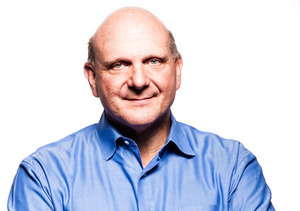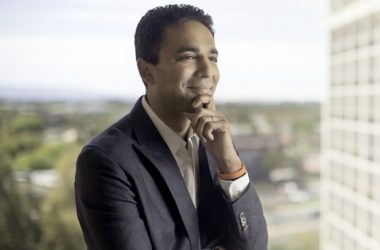Mere days into the Steve Ballmer Successor Watch, guessing who will be his replacement has become a new tech industry pastime.

Ballmer’s announcement that he will retire within the next 12 months has unleashed strong, conflicting emotions – tension and relief, sadness and joy, uncertainty and excitement – among Microsoft employees, customers, partners, investors and observers.
After all, there has never been much drama regarding the CEO post at Microsoft. There was little doubt Ballmer would get it when co-founder Bill Gates handed it over in 2000. Ballmer had been for many years his second-in-command.
The situation is much different today. Ballmer has no heir apparent, and his retirement announcement took many by surprise. It had been assumed he’d stay at the helm at least for several more years, especially since he unveiled a major company reorganization just last month.
“There’s no clear person that’s been groomed for this,” said Charlene Li, an Altimeter Group analyst.
Thus, the field is wide open, with a number of compelling candidates both inside and outside of the company. What complicates the guessing game is that it’s not clear what board directors and the newly created CEO search committee are thinking.
“The real question becomes whether Microsoft’s board wants the company to continue on its current trajectory, or whether it wants to take this opportunity to bring in an outsider with a visionary perspective,” IDC analyst Al Gillen wrote in a research note.
If the board wants the successor to continue executing on Ballmer’s reorganization, which seeks to make Microsoft operate more cohesively and transform itself from a software company into a provider of devices and services, it would be logical to look inside the company. On the other hand, if the board wants Ballmer’s strategy to be revised and altered, the replacement should come from the outside.
What’s clear is that whoever is picked will inherit a few big, well-known challenges, including Windows’ weak position in the tablet and smartphone OS market; the dismal sales of the Surface tablet; and the years-long dilemma of whether to port Office fully to iOS and Android and risk hurting Windows’ appeal.
Ballmer’s successor will also be expected to display much finer vision, so that Microsoft can be ahead in innovation and jump on hot opportunities early, instead of playing catch-up as it has in many instances during his time as CEO. Investors in particular have been impatient for years over the company’s stock price, although Microsoft has had robust profit and revenue growth under Ballmer.
With that in mind, industry watchers have a variety of ideas on what the ideal profile of Microsoft’s next CEO should be, but no one is considered a front-runner.
A logical choice within Microsoft is Satya Nadella, executive vice president of the new Cloud and Enterprise Division, who has earned widespread praise for the quality and for the sales of the products of the recently dissolved Servers & Tools Division.
“Nadella has done a fantastic job there,” said David Johnson, a Forrester Research analyst.
Specifically, Nadella has led the effort to make Windows Azure a major player in the PaaS (platform as a service) and IaaS (infrastructure as a service) markets.
“Satya is a natural leader, and unlike Ballmer, he brings engineering chops,” Johnson said, noting that in addition to computer science and engineering degrees, Nadella also has an MBA.
For Gillen, another viable internal candidate would be Kevin Turner, the company’s chief operating officer, who was CIO at Walmart and CEO of Sam’s Club.
Nucleus Research analyst Rebecca Wettemann said she would look inside the company for a top-notch technology visionary, a stellar engineer with a deep understanding of the business, of the mistakes that have been made and of the emerging technology cooking in the company’s research and development division.
“I’d look for someone who can drive innovation and can take Microsoft back to its era of technology leadership,” she said, declining to name names.
In addition to Nadella, there are other top Ballmer lieutenants whose names have been floated around in recent days, including Operating Systems Engineering Group leader Terry Myerson; Devices and Studios Engineering Group chief Julie Larson-Green; Applications and Services Engineering Group leader Qi Lu; marketing head Tami Reller; and Tony Bates, the former Skype president who was just named leader of the Business Development and Evangelism Group.
Other analysts believe Microsoft should hire an outsider who can arrive with a fresh perspective.
“They need someone who can be the marketing face of Microsoft, much like Ballmer was, while also pushing innovation, and rapidly,” said analyst Jack Gold from J. Gold Associates, via email.
Google and Apple would be good places to scout for candidates, but above all, Microsoft should avoid “recycled” CEOs like former HP chiefs Carly Fiorina and Mark Hurd, he said.
“They need someone to shake the place up and get the creative juices flowing,” he said.
A good choice could be Stephen Elop, Nokia’s CEO, who previously was president of Microsoft’s Business Division in charge of Office and a member of its senior leadership team. “Appointing him would signal that the board was finally getting serious about mobile,” Gold said.
A very good but unlikely option would be Eric Schmidt, the former Google CEO who has remained with the search company as its executive chairman. Schmidt steered Google during its dizzying growth from 2001 to 2011, when it went from being a small, privately held startup to become one of the world’s most profitable and powerful companies. Prior to that, Schmidt was Novell’s chairman and CEO and Sun Microsystems’ CTO.
“I’m not sure he’d want to leave Google, given how well it’s doing. He’s the firm hand behind the creativity. Given the right incentive, you never know,” Gold said.
Another attractive candidate would be Jon Rubinstein, who played a key part in Apple’s iPod development and later became CEO of Palm before it was sold to HP. He’s now a board director at Qualcomm. “He is a known innovator and has a big focus on mobility, which is what Microsoft needs,” Gold said.
Altimeter Group’s Li thinks another good option would be Kevin Johnson, who is retiring as Juniper Networks CEO and who worked for 16 years at Microsoft, where he led the then-Platforms and Services Division, which included Windows and online services.
Li said another option would be Paul Maritz, who was CEO of VMware until last year, remains on its board and prior to that was also a high-level executive at Microsoft.
Forrester’s Johnson concurs.”Maritz is a brilliant visionary” in the areas of cloud apps and virtualization, he said.
Microsoft could also consider Facebook’s Chief Operating Officer Sheryl Sandberg, who may be ready to take the next step and move into a CEO role, Li said.
The company could also consider bringing back Steven Sinofsky, she said. Sinofsky was in charge of Windows 8’s development and quit rather abruptly in November of last year, weeks after the product was officially released.
“What I’d look for first in a candidate is innovation and risk-taking,” Li said. “There’s a general sense that Microsoft has played it pretty safe, relying on the Office and Windows franchises. The next CEO will have to place some pretty big bets.”





